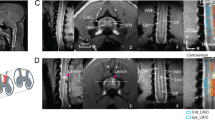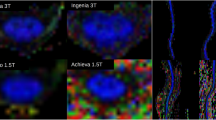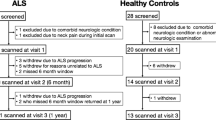Abstract
Concurrent and/or progressive degeneration of upper and lower motor neurons (LMNs) causes neurological symptoms and dysfunctions in motor neuron diseases (MNDs) such as amyotrophic lateral sclerosis (ALS). Although brain lesions are readily detected, magnetic resonance imaging of the brainstem and cervical spinal cord lesions resulting from damage to LMNs has proven to be difficult. With the development of mouse models of MNDs, a noninvasive neuroimaging modality capable of detecting lesions resulting from axonal and neuronal injury in mouse brainstem and cervical spinal cord could improve our understanding of the underlying mechanism of MNDs and aid in the development of effective treatments. Here we present a protocol that allows the concomitant acquisition of high-quality in vivo full-diffusion tensor magnetic resonance images from the mouse brainstem and cervical spinal cord using the actively decoupled, anatomically shaped pair of coils—the surface-receive coil and the minimized volume-transmit coil. To improve the data quality, we used a custom-made nose cone to monitor respiratory motion for synchronizing data acquisition and assuring physiological stability of mice under examination. The protocol allows the acquisition of in vivo diffusion tensor imaging of the mouse brainstem and cervical spinal cord at 117 μm × 117 μm in-plane resolution with a 500-μm slice thickness in 1 h on a 4.7-T horizontal small animal imaging scanner equipped with an actively shielded gradient coil capable of pulsed gradient strengths up to 18 G cm−1 with a gradient rise time of ≤295 μs.
This is a preview of subscription content, access via your institution
Access options
Subscribe to this journal
Receive 12 print issues and online access
$259.00 per year
only $21.58 per issue
Buy this article
- Purchase on Springer Link
- Instant access to full article PDF
Prices may be subject to local taxes which are calculated during checkout







Similar content being viewed by others
References
Morris, M.E. et al. Outcomes of physical therapy, speech pathology, and occupational therapy for people with motor neuron disease: a systematic review. Neurorehabil. Neural Repair 20, 424–434 (2006).
Eidelberg, E. Consequences of spinal cord lesions upon motor function, with special reference to locomotor activity. Prog. Neurobiol. 17, 185–202 (1981).
Dietz, V. Behavior of spinal neurons deprived of supraspinal input. Nat. Rev. Neurol. 6, 167–174 (2010).
Wong, P.C., Cai, H., Borchelt, D.R. & Price, D.L. Genetically engineered mouse models of neurodegenerative diseases. Nat. Neurosci. 5, 633–639 (2002).
Herson, P.S. et al. A mouse model of episodic ataxia type-1. Nat. Neurosci. 6, 378–383 (2003).
Rakhit, R. et al. An immunological epitope selective for pathological monomer-misfolded SOD1 in ALS. Nat. Med. 13, 754–759 (2007).
Williamson, T.L. & Cleveland, D.W. Slowing of axonal transport is a very early event in the toxicity of ALS-linked SOD1 mutants to motor neurons. Nat. Neurosci. 2, 50–56 (1999).
Suzuki, K. & Suzuki, Y. Globoid cell leucodystrophy (Krabbe's disease): deficiency of galactocerebroside β-galactosidase. Proc. Natl. Acad. Sci. USA 66, 302–309 (1970).
Duchen, L.W., Eicher, E.M., Jacobs, J.M., Scaravilli, F. & Teixeira, F. Hereditary leucodystrophy in the mouse: the new mutant twitcher. Brain 103, 695–710 (1980).
Bard, F. et al. Peripherally administered antibodies against amyloid β-peptide enter the central nervous system and reduce pathology in a mouse model of Alzheimer disease. Nat. Med. 6, 916–919 (2000).
Lublin, F.D. Adoptive transfer of murine relapsing experimental allergic encephalomyelitis. Ann. Neurol. 17, 188–190 (1985).
Karussis, D.M. et al. Inhibition of acute, experimental autoimmune encephalomyelitis by the synthetic immunomodulator linomide. Ann. Neurol. 34, 654–660 (1993).
Stokes, B.T. & Jakeman, L.B. Experimental modelling of human spinal cord injury: a model that crosses the species barrier and mimics the spectrum of human cytopathology. Spinal Cord 40, 101–109 (2002).
Jakeman, L.B. et al. Traumatic spinal cord injury produced by controlled contusion in mouse. J. Neurotrauma 17, 299–319 (2000).
Stejskal, E.T. & Tanner J.E. Spin echoes in the presence of a time-dependent field gradient. J. Chem. Phys. 42, 288–292 (1965).
Moseley, M.E. et al. Diffusion-weighted MR imaging of anisotropic water diffusion in cat central nervous system. Radiology 176, 439–445 (1990).
Basser, P.J., Mattiello, J. & LeBihan, D. MR diffusion tensor spectroscopy and imaging. Biophys. J. 66, 259–267 (1994).
Le Bihan, D. et al. Diffusion tensor imaging: concepts and applications. J. Magn. Reson. Imaging 13, 534–546 (2001).
Clark, C.A. & Werring, D.J. Diffusion tensor imaging in spinal cord: methods and applications—a review. NMR Biomed. 15, 578–586 (2002).
Rovaris, M. et al. Diffusion MRI in multiple sclerosis. Neurology 65, 1526–1532 (2005).
Wang, S. et al. Amyotrophic lateral sclerosis: diffusion-tensor and chemical shift MR imaging at 3.0 T. Radiology 239, 831–838 (2006).
Mori, S. & Zhang, J. Principles of diffusion tensor imaging and its applications to basic neuroscience research. Neuron 51, 527–539 (2006).
Attenberger, U.I. et al. Diffusion weighted imaging: a comprehensive evaluation of a fast spin echo DWI sequence with BLADE (PROPELLER) k-space sampling at 3 T, using a 32-channel head coil in acute brain ischemia. Invest. Radiol. 44, 656–661 (2009).
Shemesh, N., Ozarslan, E., Komlosh, M.E., Basser, P.J. & Cohen, Y. From single-pulsed field gradient to double-pulsed field gradient MR: gleaning new microstructural information and developing new forms of contrast in MRI. NMR Biomed. 23, 757–780 (2010).
Basser, P.J. & Jones, D.K. Diffusion-tensor MRI: theory, experimental design and data analysis—a technical review. NMR Biomed. 15, 456–467 (2002).
Callot, V., Duhamel, G. & Kober, F. Spinal cord—MR of rodent models. Methods Mol. Biol. 771, 355–383 (2011).
Klawiter, E.C. et al. Radial diffusivity predicts demyelination in ex vivo multiple sclerosis spinal cords. Neuroimage 55, 1454–1460 (2011).
DeBoy, C.A. et al. High resolution diffusion tensor imaging of axonal damage in focal inflammatory and demyelinating lesions in rat spinal cord. Brain 130, 2199–2210 (2007).
Cohen-Adad, J. et al. Detection of multiple pathways in the spinal cord using q-ball imaging. Neuroimage 42, 739–749 (2008).
Ong, H.H. et al. Indirect measurement of regional axon diameter in excised mouse spinal cord with q-space imaging: simulation and experimental studies. Neuroimage 40, 1619–1632 (2008).
Gaviria, M. et al. Time course of acute phase in mouse spinal cord injury monitored by ex vivo quantitative MRI. Neurobiol. Dis. 22, 694–701 (2006).
Bonny, J.M. et al. Nuclear magnetic resonance microimaging of mouse spinal cord in vivo. Neurobiol. Dis. 15, 474–482 (2004).
Schwartz, E.D. et al. Ex vivo MR determined apparent diffusion coefficients correlate with motor recovery mediated by intraspinal transplants of fibroblasts genetically modified to express BDNF. Exp. Neurol. 182, 49–63 (2003).
Budde, M.D., Xie, M., Cross, A.H. & Song, S.K. Axial diffusivity is the primary correlate of axonal injury in the experimental autoimmune encephalomyelitis spinal cord: a quantitative pixelwise analysis. J. Neurosci. 29, 2805–2813 (2009).
Kim, J.H. et al. Detecting axon damage in spinal cord from a mouse model of multiple sclerosis. Neurobiol. Dis. 21, 626–632 (2006).
Underwood, C.K., Kurniawan, N.D., Butler, T.J., Cowin, G.J. & Wallace, R.H. Non-invasive diffusion tensor imaging detects white matter degeneration in the spinal cord of a mouse model of amyotrophic lateral sclerosis. Neuroimage 55, 455–461 (2011).
Hassen, W.B. et al. Characterisation of spinal cord in a mouse model of spastic paraplegia related to abnormal axono-myelin interactions by in vivo quantitative MRI. Neuroimage 46, 1–9 (2009).
Niessen, H.G. et al. In vivo quantification of spinal and bulbar motor neuron degeneration in the G93A-SOD1 transgenic mouse model of ALS by T2 relaxation time and apparent diffusion coefficient. Exp. Neurol. 201, 293–300 (2006).
Callot, V., Duhamel, G., Cozzone, P.J. & Kober, F. Short-scan-time multi-slice diffusion MRI of the mouse cervical spinal cord using echo planar imaging. NMR Biomed. 21, 868–877 (2008).
Kim, J.H., Haldar, J., Liang, Z.P. & Song, S.K. Diffusion tensor imaging of mouse brain stem and cervical spinal cord. J. Neurosci. Methods 176, 186–191 (2009).
Kim, J.H. et al. Noninvasive diffusion tensor imaging of evolving white matter pathology in a mouse model of acute spinal cord injury. Magn. Reson. Med. 58, 253–260 (2007).
Kim, J.H. et al. Diffusion tensor imaging at 3 hours after traumatic spinal cord injury predicts long-term locomotor recovery. J. Neurotrauma. 27, 587–598 (2010).
Kim, J.H., Wu, T.H., Budde, M.D., Lee, J.M. & Song, S.K. Noninvasive detection of brainstem and spinal cord axonal degeneration in an amyotrophic lateral sclerosis mouse model. NMR Biomed. 24, 163–169 (2011).
Mogatadakala, K.V., Bankson, J.A. & Narayana, P.A. Three-element phased-array coil for imaging of rat spinal cord at 7T. Magn. Reson. Med. 60, 1498–1505 (2008).
Mogatadakala, K.V. & Narayana, P.A. In vivo diffusion tensor imaging of thoracic and cervical rat spinal cord at 7 T. Magn. Reson. Imaging 27, 1236–1241 (2009).
Duhamel, G., Callot, V., Cozzone, P.J. & Kober, F. Spinal cord blood flow measurement by arterial spin labeling. Magn. Reson. Med. 59, 846–854 (2008).
Duhamel, G. et al. Mouse lumbar and cervical spinal cord blood flow measurements by arterial spin labeling: sensitivity optimization and first application. Magn. Reson. Med. 62, 430–439 (2009).
McCreary, C.R. et al. Multiexponential T2 and magnetization transfer MRI of demyelination and remyelination in murine spinal cord. Neuroimage 45, 1173–1182 (2009).
Armitage, P.A. & Bastin, M.E. Selecting an appropriate anisotropy index for displaying diffusion tensor imaging data with improved contrast and sensitivity. Magn. Reson. Med. 44, 117–121 (2000).
Acknowledgements
This study is supported in part by National Multiple Sclerosis Society (NMSS) grant no. RG 4549A4/1 (S.-K.S.), NIH grants R01 NS 047592 and P01 NS 059560 (S.-K.S.). We thank A. Cross for critically reading the manuscript.
Author information
Authors and Affiliations
Contributions
J.H.K. performed all experimental measurements and analyses, designed and fabricated all devices, and wrote the manuscript. S.-K.S. designed devices and experiments, and wrote the manuscript.
Corresponding author
Ethics declarations
Competing interests
The authors declare no competing financial interests.
Rights and permissions
About this article
Cite this article
Kim, J., Song, SK. Diffusion tensor imaging of the mouse brainstem and cervical spinal cord. Nat Protoc 8, 409–417 (2013). https://doi.org/10.1038/nprot.2013.012
Published:
Issue Date:
DOI: https://doi.org/10.1038/nprot.2013.012
This article is cited by
-
Benefits of high-dielectric pad for neuroimaging study in 7-Tesla MRI
Journal of Analytical Science and Technology (2023)
-
Dynamic response of microglia/macrophage polarization following demyelination in mice
Journal of Neuroinflammation (2019)
-
Paclitaxel causes degeneration of both central and peripheral axon branches of dorsal root ganglia in mice
BMC Neuroscience (2016)
Comments
By submitting a comment you agree to abide by our Terms and Community Guidelines. If you find something abusive or that does not comply with our terms or guidelines please flag it as inappropriate.



